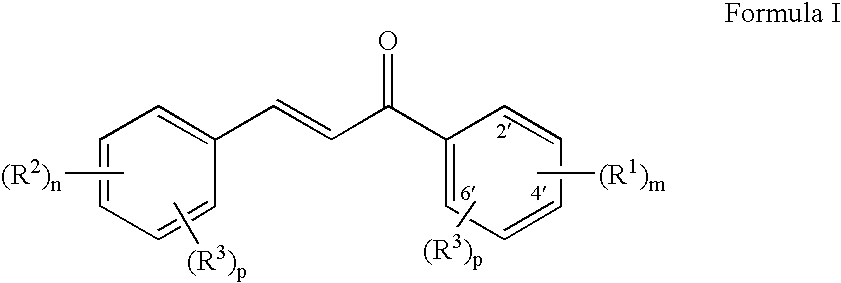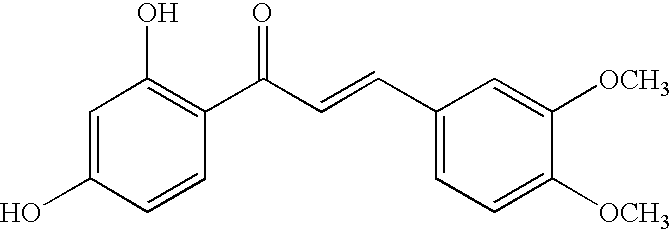Use of chalcones for the treatment of viral disorders
a technology of chalcones and chalcones, which is applied in the field of use of chalcones for the treatment of viral disorders, can solve the problems of contagious and recurrence of cold sores, serious dangers to an infected individual, and cold sores
- Summary
- Abstract
- Description
- Claims
- Application Information
AI Technical Summary
Benefits of technology
Problems solved by technology
Method used
Image
Examples
example 1
HSV-1 Assay
[0117] Vero cells (ATCC CCL-81) are pregrown in 96-well tissue culture plates using Dulbecco's Modified Eagle's Medium (DMEM) supplemented with 10% heat-inactivated fetal bovine serum (FBS), L-Glutamine, penicillin, and streptomycin.
[0118] To each of the replicate cell cultures is added 50 μL of the test article solution and 50 μL of virus suspension (ATCC VR-260). The multiplicity of infection used is about 0.05 plaque-forming unit (PFU) per cell. Cell controls containing medium alone, virus-infected controls containing medium and virus, drug cytotoxicity controls containing medium and each drug concentration, reagent controls containing culture medium only (no cells), and the test article colorimetric controls containing the test article and medium (no cells) are run simultaneously with the test samples. The plates are incubated at 37° C. in a humidified atmosphere containing 5% CO2 until maximum CPE (cytopathic effect) is observed in the untreated virus control cultu...
example 2
Inflammation Assay—Cell E-Selectin Assay
[0122] Endothelial-Leukocyte Adhesion Molecule (ELAM), also known as E-selectin, was expressed on the surface of endothelial cells. In this assay, lipopolysaccharide (LPS) and IL-1β were used to stimulate the expression of E-selectin, test agents were tested for their abilities to reduce this expression, in accordance with studies showing that reduction of leukocyte adhesion to endothelial cell surface was associated with decreased cellular damage (e.g., Takada, M., Et al., Transplantation 64: 1520-25, 1997; Steinberg, J. B., et al., J. Heart Lung Trans. 13:306-313, 1994).
[0123] Endothelial cells may be selected from any of a number of sources and cultured according to methods known in the art, including, for example, coronary artery endothelial cells, human brain microvascular endothelial cells (HBMEC; Hess, D.C., et al., Neurosci. Lett. 213(1): 37-40, 1996), or lung endothelial cells. Cells were conveniently cultured in 96-well plates. Cel...
example 3
Inflammation Assay—IL-6 Assay
[0125] The purpose of this assay is to measure IL-6 from a macrophage cell using an ELISA technique. This assay measures the release of IL-6 from a rat macrophage cell line (NR8383) following an inflammatory challenge with LPS and the ability of test articles to inhibit this activation and release. IL-6 is measured by a rat IL-6 ELISA (IL-6 ELISA kit is available by Pierce / Endogen #ER2-IL6) and cell toxicity is determined using Cell Tracker.
Materials and Equipments:
[0126] Materials for Cell Preparation and Experiment [0127] NR8383 cell line (ATCC #CRL-2192) [0128] Kaighn's F12 media (Gibco #211127-022) [0129] FBS (Hyclone SH30070.03) [0130] Penicillin / Streptomycin, 100× (Gibco 15140-122). [0131] LPS (Sigma L2537) (stock at 5 mg / ml in DMSO, aliquot and store in the freezer) [0132] Cell Tracker Green (Molecular Probe # C2925 1 mg or #C7025 20*50) [0133] Cell tracker MW=465 (10 mM is 1 mg in 215 uL DMSO aliquot and store in the freezer) [0134] HBSS buff...
PUM
| Property | Measurement | Unit |
|---|---|---|
| concentrations | aaaaa | aaaaa |
| concentrations | aaaaa | aaaaa |
| concentration | aaaaa | aaaaa |
Abstract
Description
Claims
Application Information
 Login to View More
Login to View More - R&D
- Intellectual Property
- Life Sciences
- Materials
- Tech Scout
- Unparalleled Data Quality
- Higher Quality Content
- 60% Fewer Hallucinations
Browse by: Latest US Patents, China's latest patents, Technical Efficacy Thesaurus, Application Domain, Technology Topic, Popular Technical Reports.
© 2025 PatSnap. All rights reserved.Legal|Privacy policy|Modern Slavery Act Transparency Statement|Sitemap|About US| Contact US: help@patsnap.com



